Autumn Surface Wind Trends over California during 1979–2020
Abstract
:1. Introduction
2. Datasets and Trend Method
3. Results
3.1. Reanalysis Trends
3.2. RAWS Trends
3.3. Potential Physical Mechanisms
4. Discussion and Conclusions
Author Contributions
Funding
Data Availability Statement
Acknowledgments
Conflicts of Interest
References
- Williams, A.P.; Abatzoglou, J.T.; Gershunov, A.; Guzman-Morales, J.; Bishop, D.A.; Balch, J.K.; Lettenmaier, D.P. Observed Impacts of Anthropogenic Climate Change on Wildfire in California. Earth’s Future 2019, 7, 892–910. [Google Scholar] [CrossRef]
- Westerling, A.L.; Hidalgo, H.G.; Cayan, D.R.; Swetnam, T.W. Warming and Earlier Spring Increase Western U.S. Forest Wildfire Activity. Science 2006, 313, 940–943. [Google Scholar] [CrossRef] [PubMed]
- Goss, M.; Swain, D.L.; Abatzoglou, J.T.; Sarhadi, A.; Kolden, C.A.; Williams, A.P.; Diffenbaugh, N.S. Climate change is increasing the likelihood of extreme autumn wildfire conditions across California. Environ. Res. Lett. 2020, 15, 14. [Google Scholar] [CrossRef]
- Luković, J.; Chiang, J.C.H.; Blagojević, D.; Sekulić, A. A Later Onset of the Rainy Season in California. Geophys. Res. Lett. 2021, 48, e2020GL090350. [Google Scholar] [CrossRef]
- Swain, D.L. A Shorter, Sharper Rainy Season Amplifies California Wildfire Risk. Geophys. Res. Lett. 2021, 48, e2021GL092843. [Google Scholar] [CrossRef]
- Schroeder, M.; Buck, C. Fire Weather: A Guide for Application of Meteorological Information to Forest Fire Control. USDA Forest Service, Agriculture Handbook 360; 1970; p. 236. Available online: https://training.nwcg.gov/pre-courses/s290/Fire_Weather_Handbook_pms_425.pdf (accessed on 27 September 2023).
- Ruscha, C. Forecasting the Mono Wind. NOAA Tech. Memo, NWS WR-105, National Weather Service. 1976; p. 27. Available online: https://repository.library.noaa.gov/view/noaa/7025/noaa_7025_DS1.pdf (accessed on 27 September 2023).
- Edinger, J.; Helvey, R.; Baumhefner, D. Surface Wind Patterns in the Los Angeles Basin during “Santa Ana” Conditions. In Pacific Southwest Forest and Range Experiment Station; Forest Service; U.S. Department of Agriculture: Washington, DC, USA, 1964. [Google Scholar]
- Sommers, W.T. LFM Forecast Variables Related to Santa Ana Wind Occurrences. Mon. Weather Rev. 1978, 106, 1307–1316. [Google Scholar] [CrossRef]
- Raphael, M.N. The Santa Ana Winds of California. Earth Interact. 2003, 7, 1–13. [Google Scholar] [CrossRef]
- Blier, W. The Sundowner Winds of Santa Barbara, California. Weather Forecast. 1998, 13, 702–716. [Google Scholar] [CrossRef]
- Cannon, F.; Carvalho, L.M.; Jones, C.; Hall, T.; Gomberg, D.; Dumas, J.; Jackson, M. WRF simulation of downslope wind events in coastal Santa Barbara County. Atmos. Res. 2017, 191, 57–73. [Google Scholar] [CrossRef]
- Hatchett, B.J.; Smith, C.M.; Nauslar, N.J.; Kaplan, M.L. Brief Communication: Synoptic-scale differences between Sundowner and Santa Ana wind regimes in the Santa Ynez Mountains, California. Nat. Hazards Earth Syst. Sci. 2018, 18, 419–427. [Google Scholar] [CrossRef]
- Jones, C.; Carvalho, L.M.; Duine, G.J.; Zigner, K. Climatology of Sundowner winds in coastal Santa Barbara, California, based on 30-yr high resolution WRF downscaling. Atmos. Res. 2021, 249. [Google Scholar] [CrossRef]
- Nauslar, N.J.; Abatzoglou, J.T.; Marsh, P.T. The 2017 North Bay and Southern California Fires: A Case Study. Fire 2018, 1, 18. [Google Scholar] [CrossRef]
- Coen, J.L.; Schroeder, W.; Quayle, B. The Generation and Forecast of Extreme Winds during the Origin and Progression of the 2017 Tubbs Fire. Atmosphere 2018, 9, 462. [Google Scholar] [CrossRef]
- Fovell, R.G.; Gallagher, A. Winds and Gusts during the Thomas Fire. Fire 2018, 1, 47. [Google Scholar] [CrossRef]
- Kolden, C.A.; Henson, C. A Socio-Ecological Approach to Mitigating Wildfire Vulnerability in the Wildland Urban Interface: A Case Study from the 2017 Thomas Fire. Fire 2019, 2, 9. [Google Scholar] [CrossRef]
- Brewer, M.J.; Clements, C.B. The 2018 Camp Fire: Meteorological Analysis Using In Situ Observations and Numerical Simulations. Atmosphere 2020, 11, 47. [Google Scholar] [CrossRef]
- Mass, C.F.; Ovens, D. The Northern California Wildfires of 8-9 October 2017: The Role of a Major Downslope Wind Event. Bull. Am. Meteorol. Soc. 2019, 100, 235–256. [Google Scholar] [CrossRef]
- Seto, D.; Jones, C.; Trugman, A.T.; Varga, K.; Plantinga, A.J.; Carvalho, L.M.V.; Thompson, C.; Gellman, J.; Daum, K. Simulating Potential Impacts of Fuel Treatments on Fire Behavior and Evacuation Time of the 2018 Camp Fire in Northern California. Fire 2022, 5, 37. [Google Scholar] [CrossRef]
- Zhong, S.; Li, J.; Clements, C.B.; Wekker, S.F.J.D.; Bian, X. Forcing Mechanisms for Washoe Zephyr—A Daytime Downslope Wind System in the Lee of the Sierra Nevada. J. Appl. Meteorol. Climatol. 2008, 47, 339–350. [Google Scholar] [CrossRef]
- Werth, P.A.; Potter, B.E.; Clements, C.B.; Finney, M.A.; Goodrick, S.L.; Alexander, M.E.; Cruz, M.G.; Forthofer, J.A.; McAllister, S.S. Synthesis of Knowledge of Extreme Fire Behavior: Volume I for Fire Managers; Technical Report; USDA: Washington, DC, USA, 2011. [CrossRef]
- Markowski, P.; Richardson, Y. Mesoscale Meteorology in Midlatitudes; John Wiley & Sons, Ltd.: Hoboken, NJ, USA, 2010; p. 407. [Google Scholar] [CrossRef]
- Rotach, M.W.; Calanca, P.; Graziani, G.; Gurtz, J.; Steyn, D.G.; Vogt, R.; Andretta, M.; Christen, A.; Cieslik, S.; Connolly, R.; et al. Turbulence Structure and Exchange Processes in an Alpine Valley: The Riviera Project. Bull. Am. Meteorol. Soc. 2004, 85, 1367–1386. [Google Scholar] [CrossRef]
- Weigel, A.P.; Chow, F.K.; Rotach, M.W. On the nature of turbulent kinetic energy in a steep and narrow Alpine valley. Bound.-Layer Meteorol. 2007, 123, 177–199. [Google Scholar] [CrossRef]
- Hughes, M.; Hall, A. Local and synoptic mechanisms causing Southern California’s Santa Ana winds. Clim. Dyn. 2009, 34, 847–857. [Google Scholar] [CrossRef]
- Rasmussen, D.J.; Holloway, T.; Nemet, G.F. Opportunities and challenges in assessing climate change impacts on wind energy—A critical comparison of wind speed projections in California. Environ. Res. Lett. 2011, 6, 024008. [Google Scholar] [CrossRef]
- García-Reyes, M.; Largier, J. Observations of increased wind-driven coastal upwelling off central California. J. Geophys. Res. Ocean. 2010, 115. [Google Scholar] [CrossRef]
- Pryor, S.C.; Barthelmie, R.J.; Young, D.T.; Takle, E.S.; Arritt, R.W.; Flory, D.; Gutowski, W.J., Jr.; Nunes, A.; Roads, J. Wind speed trends over the contiguous United States. J. Geophys. Res. Atmos. 2009, 114. [Google Scholar] [CrossRef]
- Pryor, S.C.; Ledolter, J. Addendum to “Wind speed trends over the contiguous United States”. J. Geophys. Res. Atmos. 2010, 115. [Google Scholar] [CrossRef]
- Liu, Y.C.; Di, P.; Chen, S.H.; Chen, X.; Fan, J.; DaMassa, J.; Avise, J. Climatology of Diablo winds in Northern California and their relationships with large-scale climate variabilities. Clim. Dyn. 2021, 56, 1335–1356. [Google Scholar] [CrossRef]
- McClung, B.; Mass, C.F. The Strong, Dry Winds of Central and Northern California: Climatology and Synoptic Evolution. Weather. Forecast. 2020, 35, 2163–2178. [Google Scholar] [CrossRef]
- Guzman-Morales, J.; Gershunov, A.; Theiss, J.; Li, H.; Cayan, D. Santa Ana Winds of Southern California: Their climatology, extremes, and behavior spanning six and a half decades. Geophys. Res. Lett. 2016, 43, 2827–2834. [Google Scholar] [CrossRef]
- Rolinski, T.; Capps, S.B.; Zhuang, W. Santa Ana Winds: A Descriptive Climatology. Weather Forecast. 2019, 34, 257–275. [Google Scholar] [CrossRef]
- Hersbach, H.; Bell, B.; Berrisford, P.; Hirahara, S.; Horányi, A.; Muñoz-Sabater, J.; Nicolas, J.; Peubey, C.; Radu, R.; Schepers, D.; et al. The ERA5 global reanalysis. Q. J. R. Meteorol. Soc. 2020, 146, 1999–2049. [Google Scholar] [CrossRef]
- Mesinger, F.; DiMego, G.; Kalnay, E.; Mitchell, K.; Shafran, P.C.; Ebisuzaki, W.; Jović, D.; Woollen, J.; Rogers, E.; Berbery, E.H.; et al. North American Regional Reanalysis. Bull. Am. Meteorol. Soc. 2006, 87, 343–360. [Google Scholar] [CrossRef]
- Kalnay, E.; Kanamitsu, M.; Kistler, R.; Collins, W.; Deaven, D.; Gandin, L.; Iredell, M.; Saha, S.; White, G.; Woollen, J.; et al. The NCEP/NCAR 40-Year Reanalysis Project. Bull. Am. Meteorol. Soc. 1996, 77, 437–472. [Google Scholar] [CrossRef]
- Ramon, J.; Lledó, L.; Torralba, V.; Soret, A.; Doblas-Reyes, F.J. What global reanalysis best represents near-surface winds? Q. J. R. Meteorol. Soc. 2019, 145, 3236–3251. [Google Scholar] [CrossRef]
- Jourdier, B. Evaluation of ERA5, MERRA-2, COSMO-REA6, NEWA and AROME to simulate wind power production over France. Adv. Sci. Res. 2020, 17, 63–77. [Google Scholar] [CrossRef]
- Molina, M.O.; Gutiérrez, C.; Sánchez, E. Comparison of ERA5 surface wind speed climatologies over Europe with observations from the HadISD dataset. Int. J. Climatol. 2021, 41, 4864–4878. [Google Scholar] [CrossRef]
- Chuang, H.-Y.; Manikin, G.; Treadon, R.E. The NCEP Eta Model Post Processor: A Documentation. 2001. Available online: http://www.emc.ncep.noaa.gov/officenotes/newernotes/on438.pdf (accessed on 27 September 2023).
- ECMWF. ERA5: How Are the 100 m Winds Calculated? 2019. Available online: https://confluence.ecmwf.int/pages/viewpage.action?pageId=155343870 (accessed on 27 September 2023).
- Hussain, M.; Mahmud, I. pyMannKendall: A python package for non parametric Mann Kendall family of trend tests. J. Open Source Softw. 2019, 4, 1556. [Google Scholar] [CrossRef]
- Griffin, B.J.; Kohfeld, K.E.; Cooper, A.B.; Boenisch, G. Importance of location for describing typical and extreme wind speed behavior. Geophys. Res. Lett. 2010, 37. [Google Scholar] [CrossRef]
- Abatzoglou, J.T.; Hatchett, B.J.; Fox-Hughes, P.; Gershunov, A.; Nauslar, N.J. Global climatology of synoptically-forced downslope winds. Int. J. Clim. 2021, 41, 31–50. [Google Scholar] [CrossRef]
- Torralba, V.; Doblas-Reyes, F.J.; Gonzalez-Reviriego, N. Uncertainty in recent near-surface wind speed trends: A global reanalysis intercomparison. Environ. Res. Lett. 2017, 12, 114019. [Google Scholar] [CrossRef]
- Holt, E.; Wang, J. Trends in Wind Speed at Wind Turbine Height of 80 m over the Contiguous United States Using the North American Regional Reanalysis (NARR). J. Appl. Meteorol. Climatol. 2012, 51, 2188–2202. [Google Scholar] [CrossRef]
- Millstein, D.; Solomon-Culp, J.; Wang, M.; Ullrich, P.; Collier, C. Wind energy variability and links to regional and synoptic scale weather. Clim. Dyn. 2019, 52, 4891–4906. [Google Scholar] [CrossRef]
- Parish, T.R.; Cassano, J.J. Diagnosis of the Katabatic Wind Influence on the Wintertime Antarctic Surface Wind Field from Numerical Simulations. Mon. Weather Rev. 2003, 131, 1128–1139. [Google Scholar] [CrossRef]
- Mahrt, L. Momentum Balance of Gravity Flows. J. Atmos. Sci. 1982, 39, 2701–2711. [Google Scholar] [CrossRef]
- Norris, J.; Carvalho, L.M.V.; Jones, C.; Cannon, F. Warming and drying over the central Himalaya caused by an amplification of local mountain circulation. NPJ Clim. Atmos. Sci. 2020, 3, 1. [Google Scholar] [CrossRef]
- Schwartz, M.W.; Butt, N.; Dolanc, C.R.; Holguin, A.; Moritz, M.A.; North, M.P.; Safford, H.D.; Stephenson, N.L.; Thorne, J.H.; van Mantgem, P.J. Increasing elevation of fire in the Sierra Nevada and implications for forest change. Ecosphere 2015, 6, 1–10. [Google Scholar] [CrossRef]
- Wang, Y.H.; Walter, R.K.; White, C.; Kehrli, M.D.; Hamilton, S.F.; Soper, P.H.; Ruttenberg, B.I. Spatial and temporal variation of offshore wind power and its value along the Central California Coast. Environ. Res. Commun. 2019, 1, 121001. [Google Scholar] [CrossRef]
- Sheridan, L.M.; Krishnamurthy, R.; Garcia Medina, G.; Gaudet, B.J.; Gustafson, W.I.; Mahon, A.M.; Shaw, W.J.; Newsom, R.K.; Pekour, M.; Yang, Z. Offshore Reanalysis Wind Speed Assessment Across the Wind Turbine Rotor Layer off the United States Pacific Coast. Wind. Energy Sci. Discuss. 2022, 7, 2059–2084. [Google Scholar] [CrossRef]
- U.S. Energy Information Administration. Wind Explained: Where Wind Power Is Harnessed. 2022. Available online: https://www.eia.gov/energyexplained/wind/where-wind-power-is-harnessed.php (accessed on 27 September 2023).
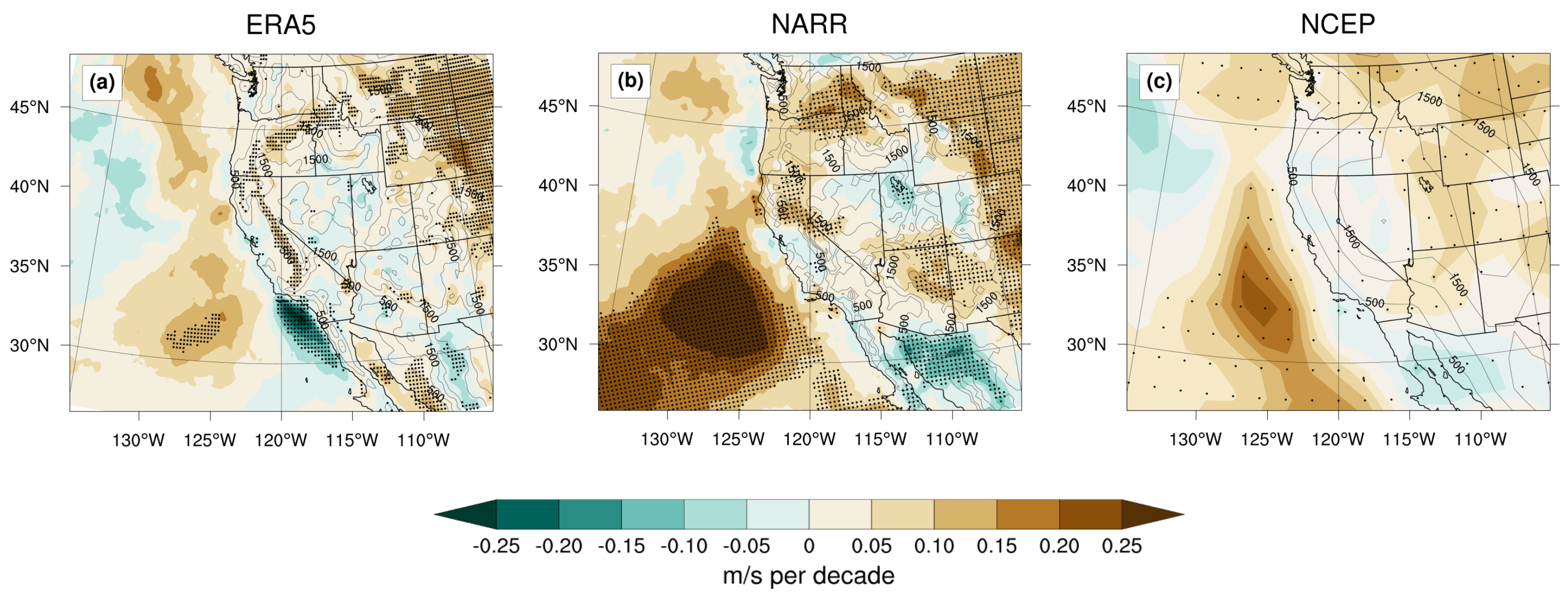
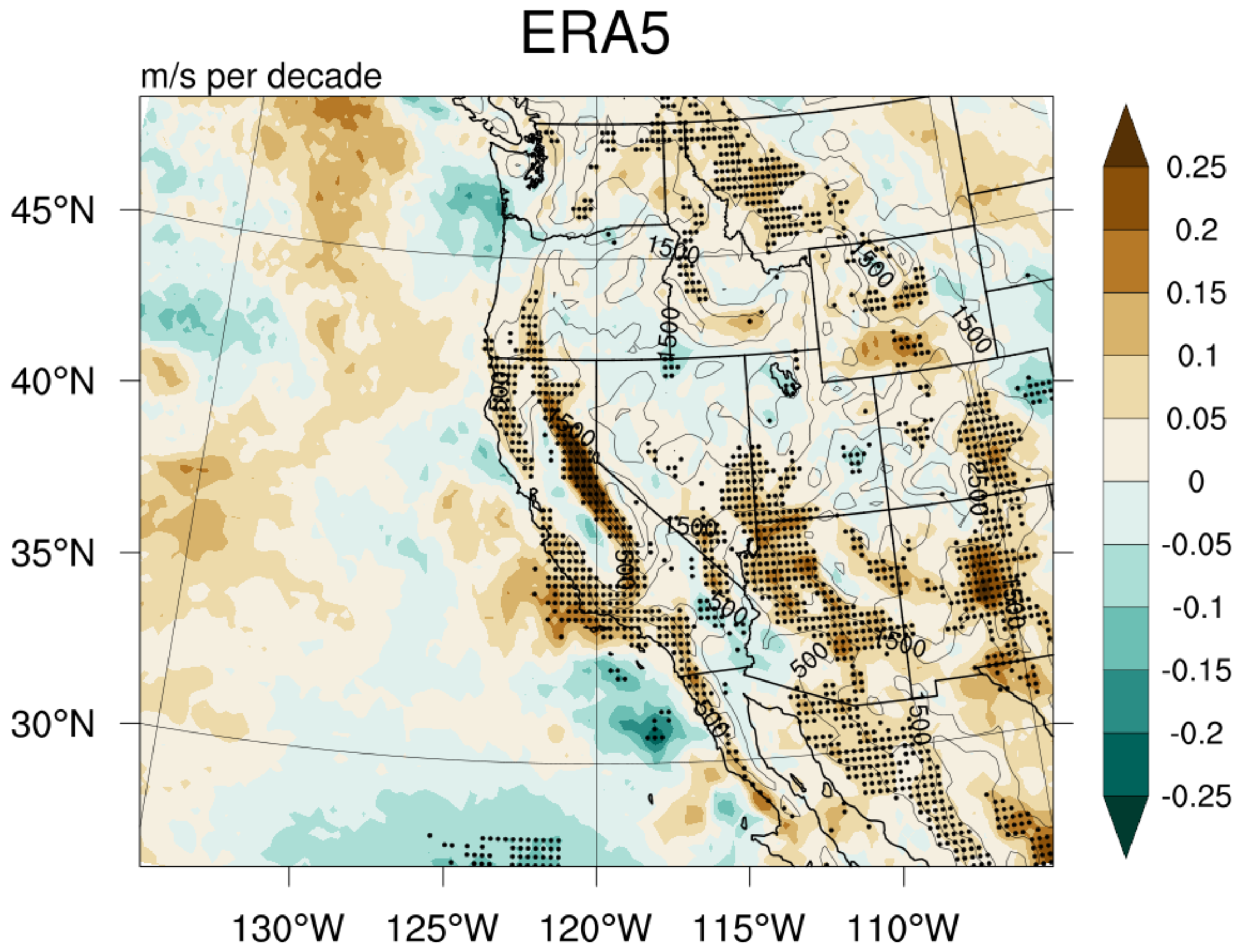
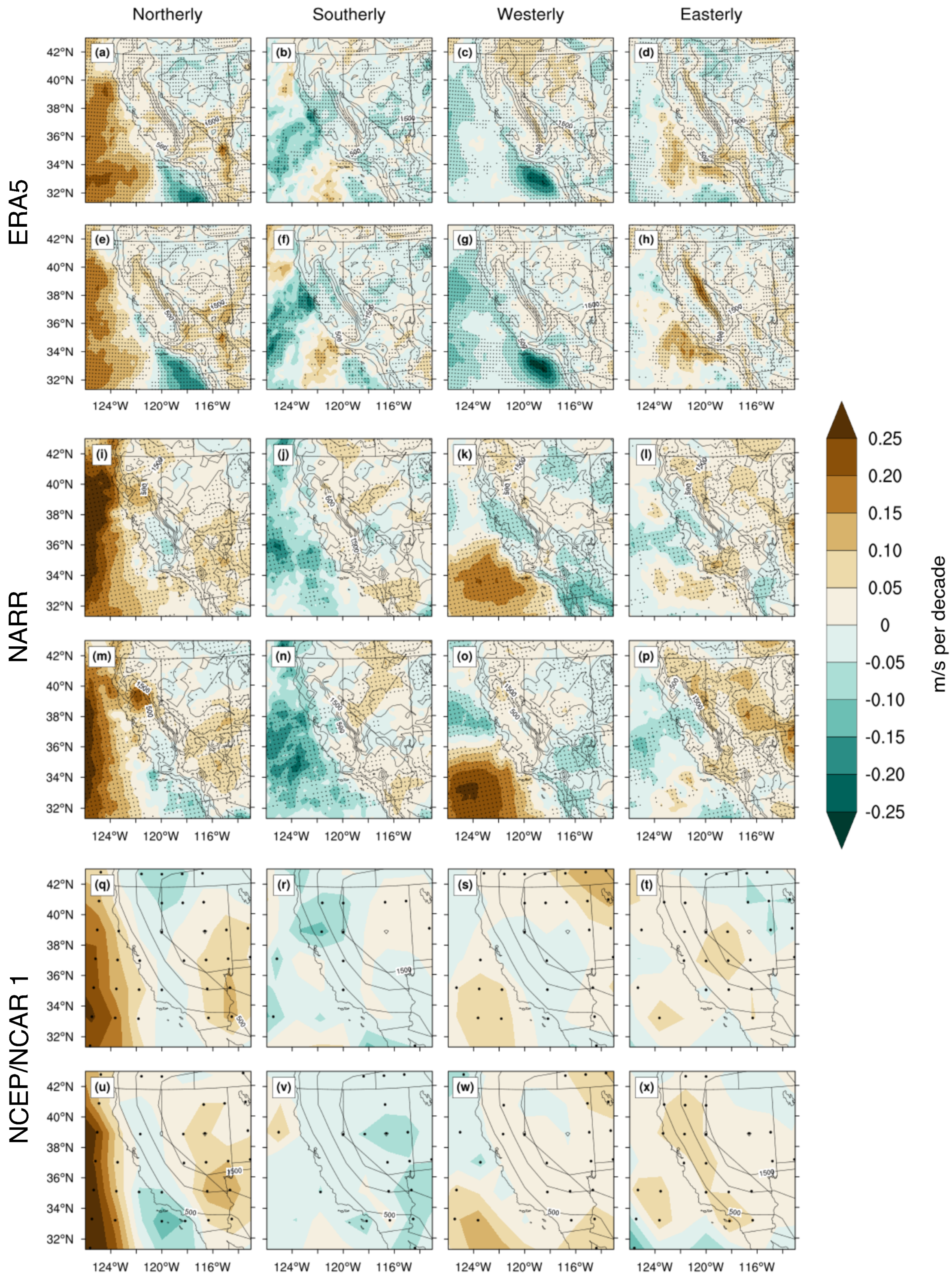
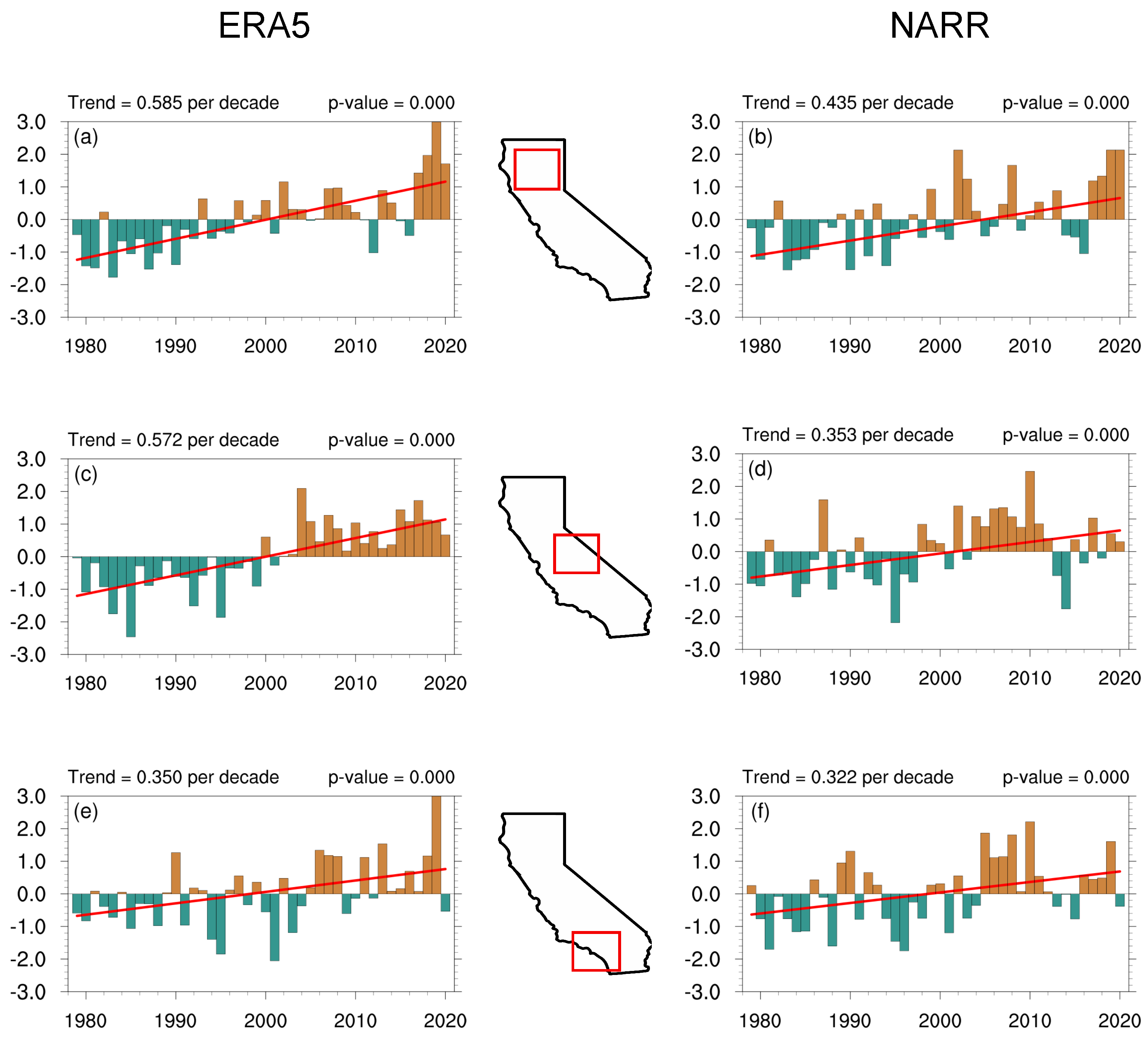
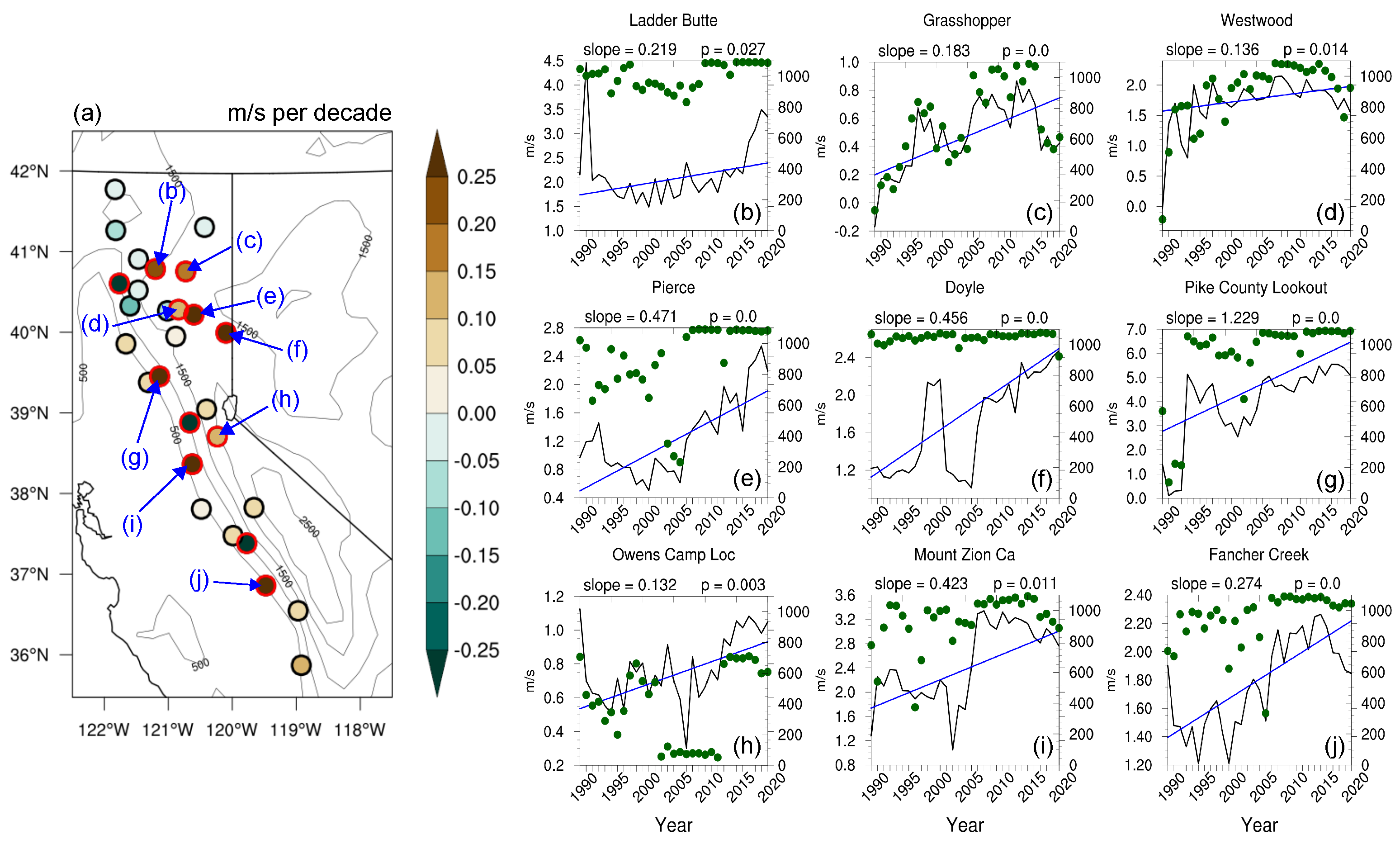
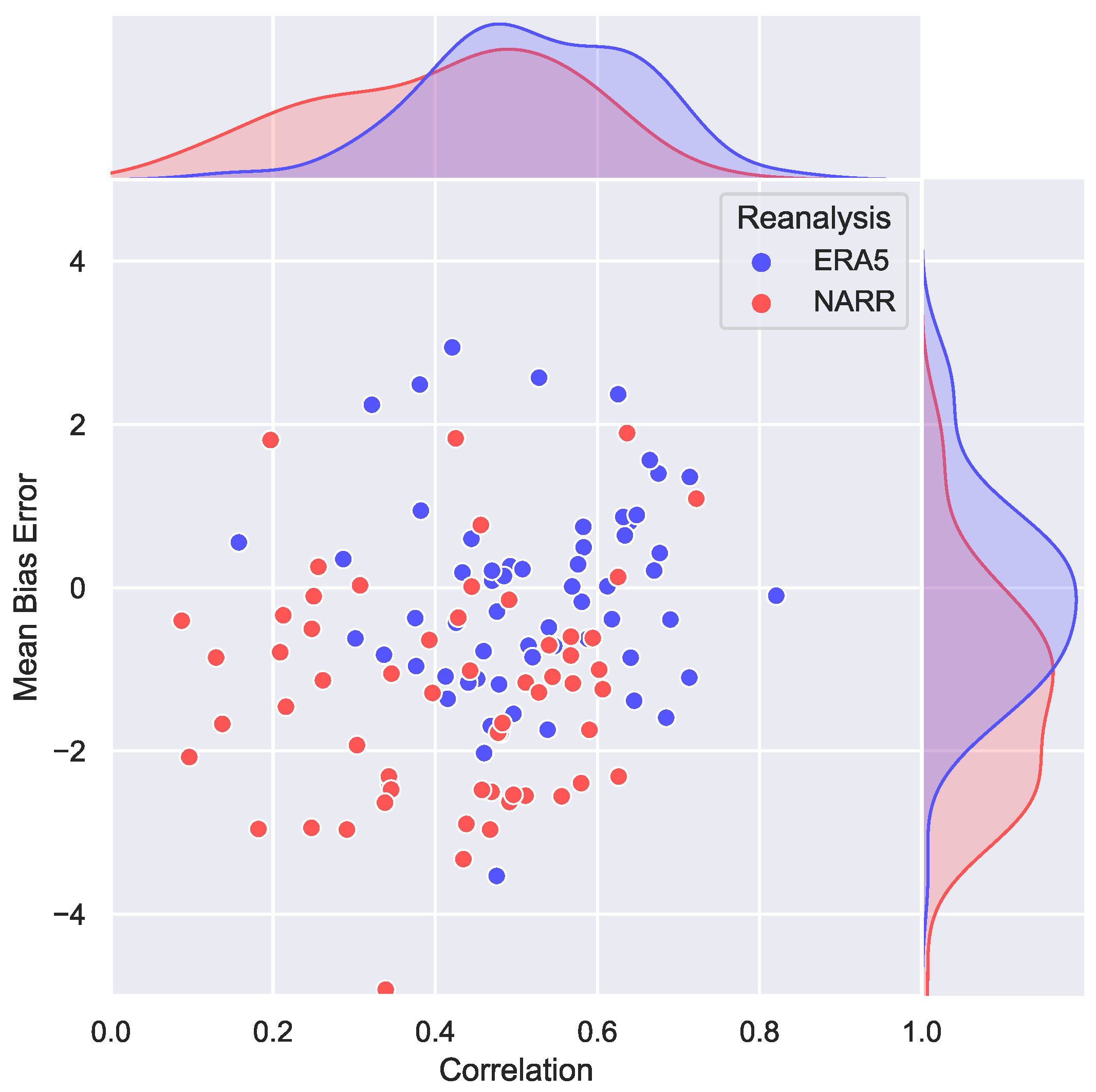
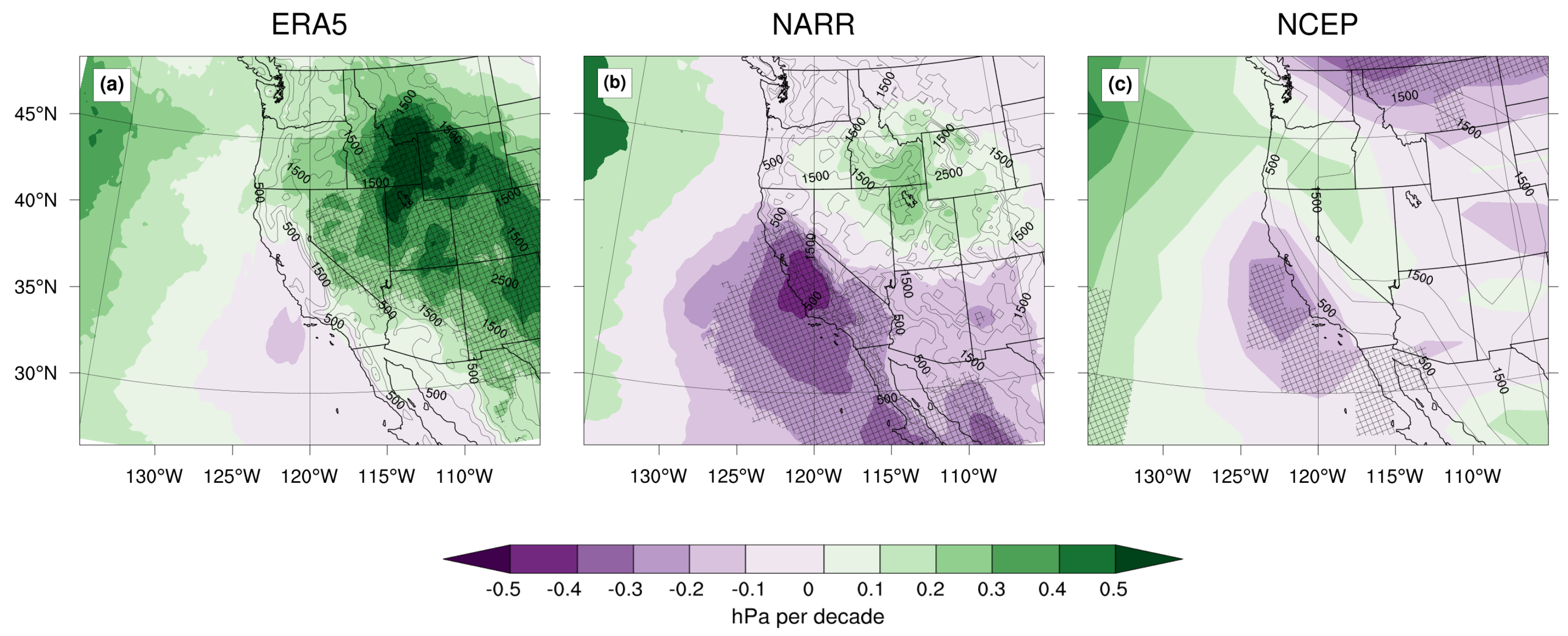

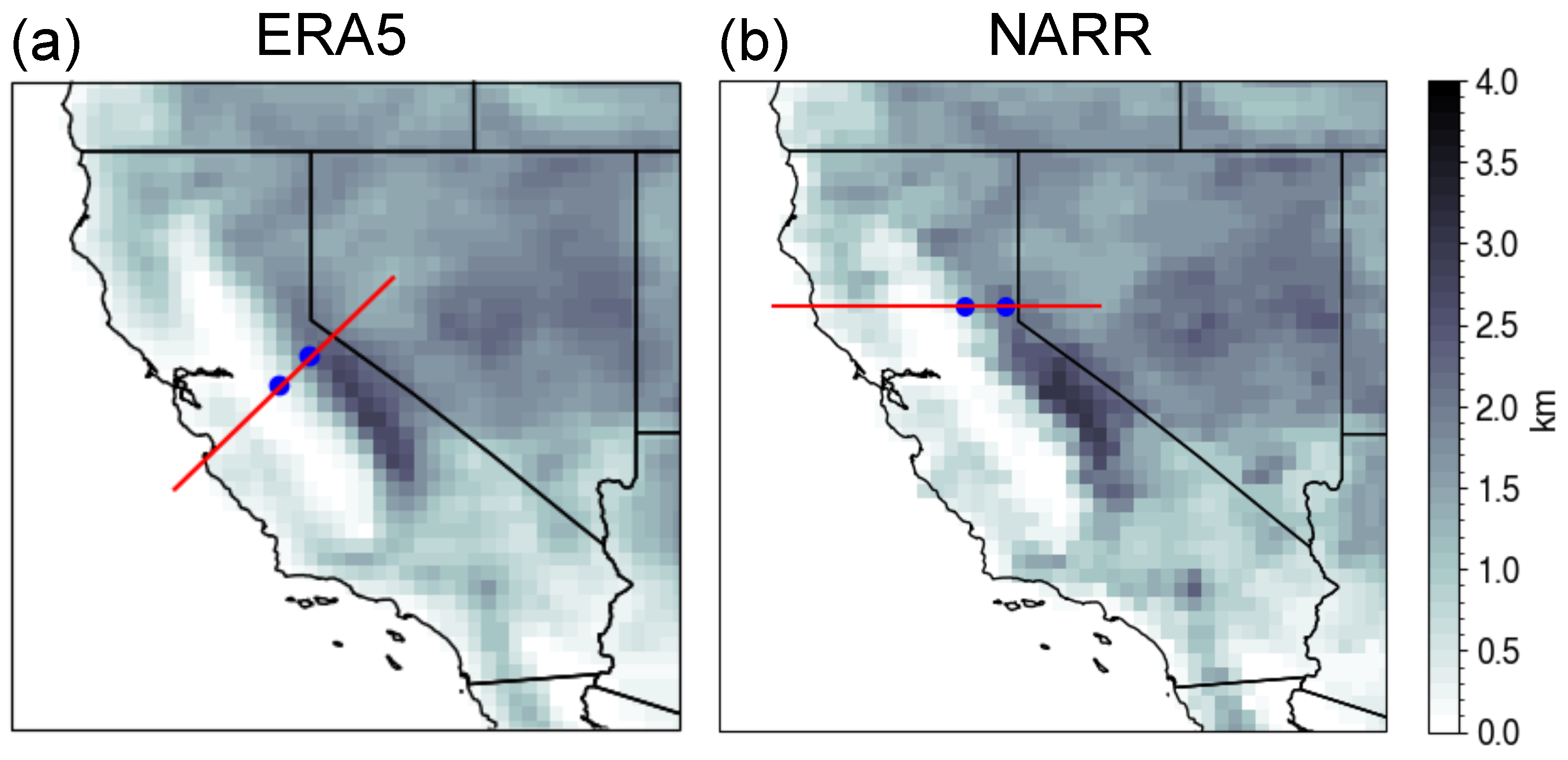

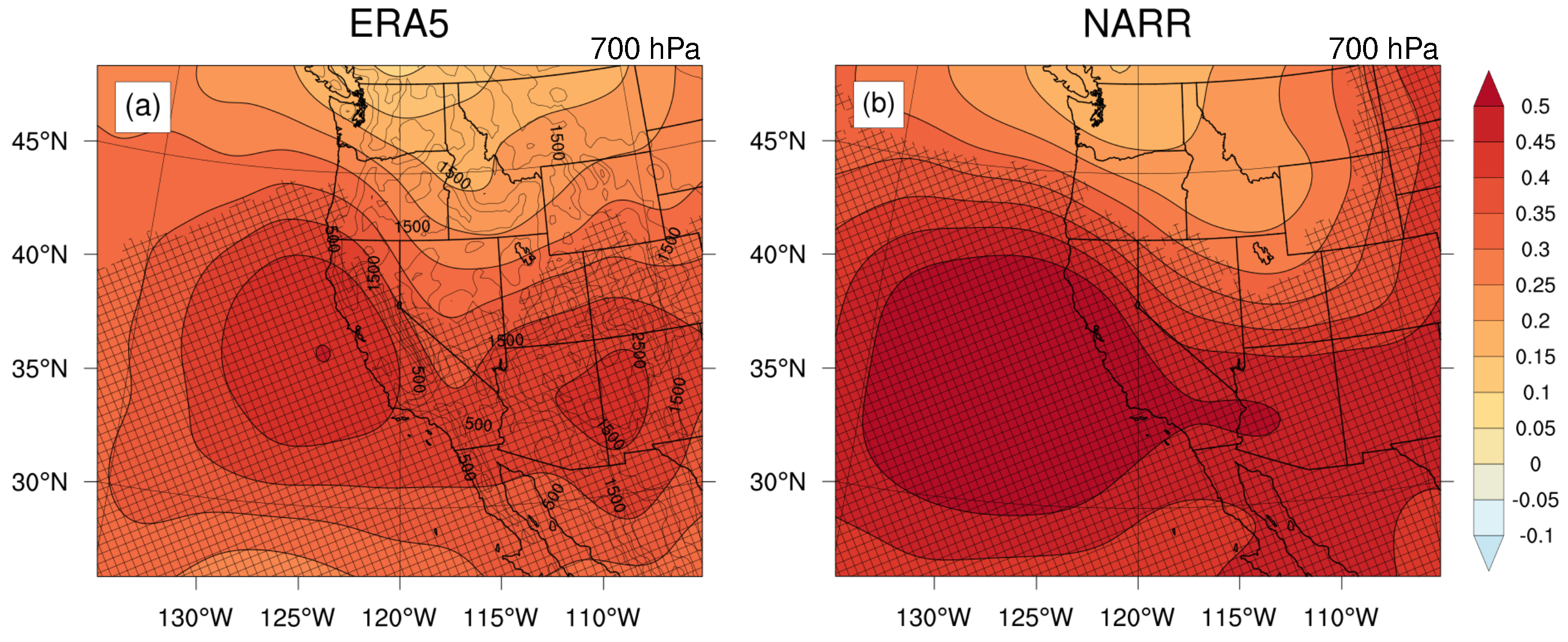
Disclaimer/Publisher’s Note: The statements, opinions and data contained in all publications are solely those of the individual author(s) and contributor(s) and not of MDPI and/or the editor(s). MDPI and/or the editor(s) disclaim responsibility for any injury to people or property resulting from any ideas, methods, instructions or products referred to in the content. |
© 2023 by the authors. Licensee MDPI, Basel, Switzerland. This article is an open access article distributed under the terms and conditions of the Creative Commons Attribution (CC BY) license (https://creativecommons.org/licenses/by/4.0/).
Share and Cite
Thompson, C.F.; Jones, C.; Carvalho, L.; Trugman, A.T.; Lucas, D.D.; Seto, D.; Varga, K. Autumn Surface Wind Trends over California during 1979–2020. Climate 2023, 11, 207. https://doi.org/10.3390/cli11100207
Thompson CF, Jones C, Carvalho L, Trugman AT, Lucas DD, Seto D, Varga K. Autumn Surface Wind Trends over California during 1979–2020. Climate. 2023; 11(10):207. https://doi.org/10.3390/cli11100207
Chicago/Turabian StyleThompson, Callum F., Charles Jones, Leila Carvalho, Anna T. Trugman, Donald D. Lucas, Daisuke Seto, and Kevin Varga. 2023. "Autumn Surface Wind Trends over California during 1979–2020" Climate 11, no. 10: 207. https://doi.org/10.3390/cli11100207
APA StyleThompson, C. F., Jones, C., Carvalho, L., Trugman, A. T., Lucas, D. D., Seto, D., & Varga, K. (2023). Autumn Surface Wind Trends over California during 1979–2020. Climate, 11(10), 207. https://doi.org/10.3390/cli11100207







